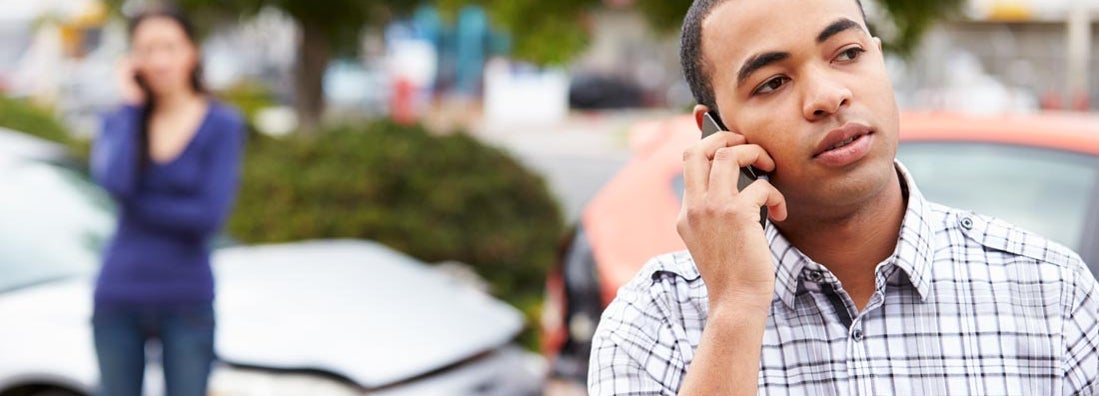Who's Responsible after an Accident Where Both Drivers Thought They Had the Right of Way?

Paul Martin is the Director of Education and Development for Myron Steves, one of the largest, most respected insurance wholesalers in the southern U.S.

Drivers face numerous risks on the road every single day. Unfortunately, one of the biggest threats to drivers is the other cars on the road. No matter how well you studied your driver’s handbook, you still can’t anticipate every move another vehicle will make. So what happens when there’s a car accident in which both drivers thought they had the right of way? Who’s responsible for this mess, anyway?
Luckily an independent insurance agent can not only answer this important question for you, but also help with getting the right coverage regardless of who’s at fault. They’ve handled all kinds of complex incidents, so they’re well suited to get you equipped with all the coverage you need, long before you’d ever need to file a claim. Here’s how they’d help you get protected against a car accident in which both drivers thought they had the right of way.
Who’s Responsible If Both Drivers Thought They Had the Right of Way before an Accident?
This actually does happen sometimes. Let’s go with a plausible example. Say Beth and Tom are on opposite sides of a four-way stop, and they’re both going to make a left-hand turn. There shouldn’t be any issue, except that the drivers end up sideswiping each other in the middle of the intersection. When interviewed by their independent insurance agents, both drivers state that they felt they had the right of way, or just plain didn’t see each other.
In this case, we’d have what’s called a 50/50 or double fault car accident. The negligence has been determined by the insurance companies as belonging to both drivers equally. Therefore, both drivers would actually be held responsible for covering the damage to both themselves and each other. Each driver would be responsible for filing a claim through their own car insurance for any vehicle damage and/or injuries.
How Would Car Property Damage Coverage Work in This Scenario?
After a 50/50 accident like the one described above, both Beth and Tom would need to rely on the property damage liability section of their car insurance. Basically, Beth’s insurance would pay for half of the damage to Tom’s car, then tap into her own insurance’s collision coverage to cover the other half of her own vehicle’s damage. Tom’s policy would work exactly the same way, but in reverse. Both policies would cover half of the other driver, and half of the policyholder.
Property damage coverage provided by auto insurance covers physical damage you do with your vehicle to another person’s car, or other property like fences, buildings, signposts, mailboxes, etc. This coverage is also mandatory, as every state’s minimum requirement for car insurance for all drivers on the road. Make sure to work with your independent insurance agent to get covered before you start driving.
How Would Car Liability Coverage Work in This Scenario?
The other main legal coverage provided by standard auto insurance policies is bodily injury liability. For our 50/50 accident, it would work much the same way as the property damage liability section. Tom’s policy would cover half of Beth’s medical payments if she got injured, and he would tap into his policy to cover the other half of his own injuries. Again, Beth’s policy would work the exact same way, but in reverse.
Bodily injury liability coverage pays for medical payments to another driver and their passengers if they’re hurt in an accident that you caused. Medical payments covers expenses for doctor and hospital visits, and often emergency services like ambulances. Since medical treatment can be extremely costly to cover out of pocket, it’s crucial to work with your independent insurance agent to get this coverage, even if it’s not mandatory in your state.
What Type of Car Insurance Covers Damage to My Vehicle?
In terms of car accidents, it would be collision coverage that reimbursed you for damage to your vehicle after the wreck. If the other driver was at fault, they’d be responsible for going through their own policy to cover repairs to your car. Collision coverage protects drivers from the following:
- Collisions with objects like trees, mailboxes, fences, and buildings.
- Collisions with other vehicles.
- Other types of accidents like running off the road into a ditch.
To help protect your vehicle from physical damage, be sure to work with your independent insurance agent to get equipped with the right collision coverage.
What Other Type of Car Insurance Is Available?
While our 50/50 accident involving Beth and Tom wouldn’t require additional coverage, it’s really important for all drivers to consider getting comprehensive insurance. This covers hazards classified as “other than collision,” including:
- Riots: If your vehicle got damaged due to shenanigans taking place during a riot, you’d be covered by comprehensive insurance.
- Glass breakage: If your windshield or windows are cracked, chipped, or shattered, you’d be covered by comprehensive insurance.
- Collision with animals: If you hit a deer or other large animal, comprehensive insurance would cover the physical damage to your vehicle. This is the only type of collision not covered under the collision section of standard auto insurance policies.
- Natural disasters and weather damage: If your vehicle got damaged by fire, a hurricane, hail, a tornado, or a flood, you’d need comprehensive coverage to pay for the repairs.
- Theft and vandalism: If your car got stolen or vandalized by keying, tagging, or something else, comprehensive coverage would reimburse you for the damage or replacement of your vehicle.
Your independent insurance agent can help you decide if adding comprehensive coverage to your car insurance is the right choice for you.
How Would This Accident Affect My Premium?
Unfortunately, even a single accident can hike up your car insurance premium. There are several factors that influence how much your premium cost might increase, like your specific vehicle, driving record, and location. On average, though, auto insurance premiums tend to rise about 7% following a not-at-fault accident. Your independent insurance agent can help you hunt for a car insurance policy with the best possible rates to start out with.
What If the Other Driver Didn’t Have Enough Insurance, or Any at All?
If you were also lacking insurance in this situation, you could end up in a really ugly mess. Uninsured and underinsured motorist coverage is an optional add-on to standard auto insurance policies. This coverage reimburses drivers if they get hit by another driver who doesn’t have any or adequate insurance to cover damage or injuries to them or their passengers. Talk to your independent insurance agent about the importance of adding this coverage to your policy.
Why Else Is Car Insurance So Important?
If you’re not yet convinced of just how critical it is to have the right protection for you and your vehicle, go ahead and check out these examples of the most common car insurance claims out there.
A few of the most common car insurance claims include:
- Damaged windshields: Windshields can be chipped or cracked by a myriad of things, including large trucks that kick up rocks on the freeway. Comprehensive auto insurance helps protect against damaged windshields.
- Rear-end collisions: The most common car insurance claims, by far, are rear-end collisions. Collision insurance reimburses for the damage to a driver’s vehicle if they get rear-ended, since they aren’t at fault.
- Whiplash: Following rear-end collisions, the most common injury reported by drivers is whiplash. In serious cases, medical treatment is often required. Car insurance reimburses for the costs of drivers’ care and recovery.
Your independent insurance agent can rattle off another handful or even more reasons why having the proper car insurance is absolutely necessary before you ever hit the road.
Here’s How an Independent Insurance Agent Would Help
When it comes to protecting drivers against 50/50 fault accidents and all other perils, no one’s better equipped to help than an independent insurance agent. These agents search through multiple carriers to find providers who specialize in auto insurance, deliver quotes from a number of different sources, and help you walk through them all to find the best blend of coverage and cost.
iii.org
